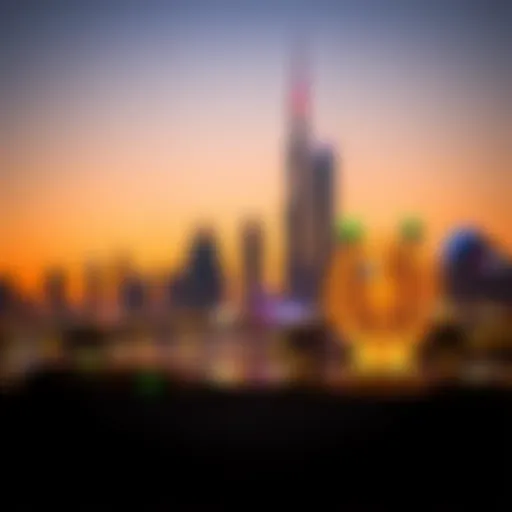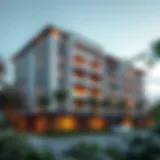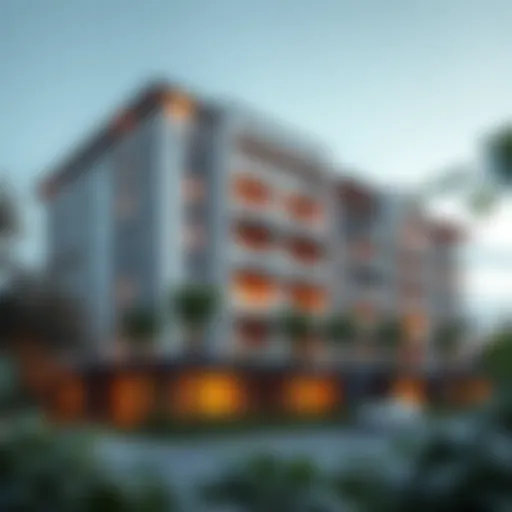Burj Khalifa: Architectural Marvel in Dubai
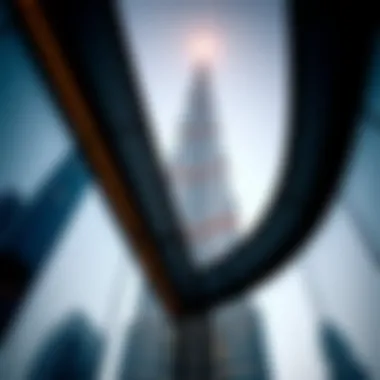

Intro
Dubai has long held the title of a thriving metropolis, and at its heart stands the Burj Khalifa, an architectural delight that surpasses mere functionality. Towering a staggering 828 meters, this skyscraper isn’t just a sight for sore eyes; it represents a blend of cultural aspiration and cutting-edge engineering prowess. But its significance doesn’t end with its height. This article seeks to peel back the layers of the Burj Khalifa, examining not only its design and construction but also its implications for Dubai's real estate landscape, tourism, and urban philosophical approach.
By exploring the Burj Khalifa’s architectural and engineering marvels, we set the stage for a deeper understanding of the ongoing property trends in Dubai. The dynamism of Dubai's property market makes it unique, and the Burj Khalifa plays a pivotal role in shaping these trends, thereby influencing investment strategies and opportunities for various stakeholders.
Get ready to delve into the framework of innovation that supports the world's tallest building, from engineering challenges that nearly derailed its completion to its prominent place on the world stage as a beacon of modern architectural ingenuity.
Property Trends in Dubai
As demand for luxury living rises, the Burj Khalifa has impacted property trends in Dubai in a major way.
Emerging Neighborhoods and Hotspots
In recent years, areas surrounding the Burj Khalifa have burgeoned into sought-after neighborhoods. Take Downtown Dubai, with its blend of upscale dining, shopping, and entertainment — it is often regarded as the epicenter of the city's real estate boom. The Dubai Mall acts as a powerful magnet for retail buyers and tourists alike, fueling demand for residential spaces in its vicinity. Likewise, the development of Dubai Creek Harbour signifies a shift toward mixed-use spaces that promise a work-and-play environment, generating substantial interest among investors and buyers.
However, neighborhoods like Jumeirah Lakes Towers and Business Bay are not to be overlooked. They offer competitive prices and growing amenities, making them attractive alternatives for potential homeowners and investors who wish to be near the Burj Khalifa.
Market Analysis and Future Predictions
The property marketplace in Dubai frequently experiences fluctuations, dictated by a variety of factors including economic conditions, regulations, and international demand. In recent years, the introduction of more favorable visas and incentives for investors has reignited interest. Now, more-than-ever, the Burj Khalifa serves as a symbol of stability and luxury.
Predictions suggest a sustainable growth trajectory, particularly in high-end properties. According to various analysts, sectors around the Burj Khalifa will see increased activity as luxury brands expand, attracting affluent buyers. Citizens and expatriates alike are recognizing the potential in high-rise living, with properties in Dubai currently offering durable rental yields that are hard to come by elsewhere.
> "The Burj Khalifa is not merely a landmark; it has become a lifestyle, embodying luxury and aspirations for both residents and investors."
This observation encapsulates its cultural significance. As Dubai continues to evolve, the Burj Khalifa will likely retain its status as a touchstone for real estate. Investors, agents, developers, and planners should keep a close eye on the shifts instigated by this and other architectural marvels in the city.
Investment Opportunities
With the increase in interest surrounding the Burj Khalifa and its surrounding locales, there arises a plethora of investment opportunities.
High-ROI Property Types
Real estate around the Burj Khalifa caters to a discerning clientele. Here are some property types that yield high returns on investment:
- Luxury apartments: High-quality finishes and amenities attract premium rental prices.
- Commercial spaces: Due to the influx of businesses, commercial real estate is gaining traction.
- Hotel apartments: Merging luxury with flexibility, these properties appeal to both long-term residents and short-term tourists.
Financing and Mortgage Options
Navigating the financial landscape can feel like wandering through a maze. Options like fixed-rate mortgages and adjustable-rate mortgages are available, depending on individual circumstances. Many banks in the UAE provide tailored packages that can accommodate both local and international investors. It’s advisable to compare offers and consult with professionals to find the best fit for your investment strategy.
For further reading on real estate financing in Dubai, potential investors can explore resources available on Dubai Land Department or consult with experts on platforms such as Bahrain Bay Development.
By being well-informed on trends and available property types, stakeholders can position themselves favorably in a constantly evolving market. The influence of the Burj Khalifa will continue to resonate, offering unique opportunities that transcend conventional real estate boundaries.
Prolusion to the Burj Khalifa
The Burj Khalifa stands tall, not just in terms of height but also in significance within the realm of architectural and urban design. Situated in the heart of Dubai, it is more than just a skyscraper; it serves as a symbol of ambition, innovation, and economic vitality. This iconic structure reflects the rapid transformation of Dubai from a modest trading village into a bustling metropolis that attracts global attention.
Historical Context
Before the Burj Khalifa, Dubai was a comparative newcomer on the world stage. In the early 2000s, the leaders of Dubai envisioned a landmark that would redefine the skyline and embody the city's aspirations. Built as part of the larger Downtown Dubai development, this tower was conceptualized to be a catalyst for growth, both culturally and economically. The decision to create the tallest building in the world was motivated by a desire to enhance tourism as well as to attract international talent. With its completion in 2010, the Burj Khalifa became a focal point, symbolizing the remarkable journey of the Emirates over a short span of time.
Architectural Vision
At its core, the Burj Khalifa is a canvas of architectural genius, crafted by the renowned designer Adrian Smith of Skidmore, Owings & Merrill. The design draws inspiration from Islamic architecture, particularly in its spiraling design reminiscent of a minaret, but with a modern twist that challenges traditional form. The Burj employs a unique triple-lobed footprint, symbolizing tranquility and harmony. There’s much to be said about the aesthetic choices, which are complemented by a careful consideration of functional needs, such as wind resistance and structural integrity, given the building’s height. This engineering marvel utilizes high-strength concrete, allowing it to withstand the environmental stresses of the desert climate.
Global Recognition
Since its opening, the Burj Khalifa has garnered international acclaim. It holds not just regional but global recognition as the tallest structure in the world, standing at an astonishing 828 meters. This achievement has placed Dubai on the map as a hub for modern architecture, spurring cities across the globe to rethink their skylines. The Burj Khalifa has hosted numerous events, including the spectacular New Year’s Eve fireworks, which attract visitors from around the world. This aspect of the tower has made it a marketing powerhouse, promoting Dubai as a must-visit destination, thereby integrating cultural experiences with urban exploration.
The Burj Khalifa encapsulates a transformative era for Dubai, where architectural brilliance and economic ambition intersect. This tower is not just a building; it’s a story of vision realized, a conversation starter about the future of urban livability, and a monument to collective human ingenuity.
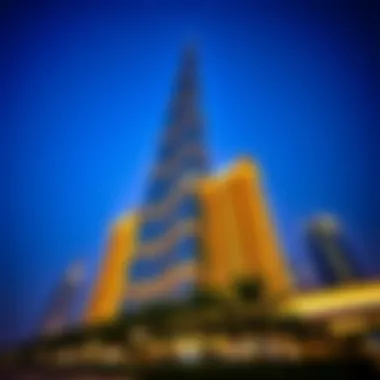

Architectural Design Principles
The Burj Khalifa stands not only as a symbol of Dubai's skyline but also as a remarkable representation of architectural design principles that push the envelope of modern construction. These principles reflect the fusion of creativity, functionality, and sustainability. This section will delve into three critical aspects of architecture that contributed to the Burj Khalifa's success – inspiration from nature, groundbreaking engineering, and sustainable features.
Inspiration from Nature
The design of the Burj Khalifa draws from the organic forms found in nature. Its structure is reminiscent of a desert flower that blooms toward the sun, allowing it to integrate harmoniously with its surroundings. The building's tiered structure mimics the natural, cascading patterns observed in flora, which not only enhances its visual appeal but also serves an important function in wind resistance.
This biophilic design approach connects occupants to the natural world, improving their psychological well-being. The observation deck at the top, which stretches outward, provides spectacular views that reflect the horizon and the surrounding landscape, showcasing the amalgamation of human ingenuity with the beauty of nature.
"Architecture should speak of its time and place, but yearn for timelessness." — Frank Gehry
Innovative Structural Engineering
Innovative engineering techniques are at the very heart of the Burj Khalifa's design. The building features a central core that is surrounded by three wings, which dramatically enhances its stability. By employing a buttressed core structural system, the designers effectively manage lateral forces, enabling the skyscraper to withstand extreme wind pressures that whip through the local environment.
Each of the building’s materials was chosen for durability and efficiency. The combination of high-performance concrete and robust steel not only reduces weight but also ensures longevity. The engineers had to calculate load capacities and stress points with extreme precision, making the Burj Khalifa a benchmark in architectural engineering. This manner of innovative design has, in turn, influenced other high-rise buildings globally, cementing its status as a paradigm of modern engineering.
Sustainable Building Features
Sustainability was a major principle in the Burj Khalifa's design. It's equipped with systems and materials meant to minimalize its environmental footprint while maximizing energy efficiency. For instance, its advanced cooling systems reduce energy waste, while the water recycling system recycles approximately 15 million gallons of wastewater annually — enough to fill over twenty Olympic-sized swimming pools.
The use of reflective glazing also plays a key role in energy conservation by minimizing heat gain from the sun. In addition, the structure incorporates green spaces at various levels, fostering biodiversity within an urban context and promoting natural ventilation. This balance between luxury and eco-consciousness serves as a forward-thinking model for future developments.
In summary, architectural design principles like drawing inspiration from nature, pioneering structural engineering, and embedding sustainability practices are integral to understanding the Burj Khalifa’s impact. These elements not only define the building's aesthetic and structural qualities but also underline its role as a leader in contemporary architecture, setting a precedent for future high-rise constructions.
Construction Journey
The construction of the Burj Khalifa is a remarkable saga that showcases the complexities and triumphs associated with building the tallest structure in the world. This narrative is not just about bricks and mortar; it is deeply intertwined with the evolution of Dubai's skyline and the economic aspirations of the United Arab Emirates. The significance of detailing this construction journey extends beyond mere facts; it illuminates the monumental efforts, precise planning, and the innovative spirit that drove this endeavor.
Planning and Design Phase
The planning and design phase of the Burj Khalifa was a meticulous process, encapsulating the vision of turning an ambitious idea into a tangible reality. Architectural firm Skidmore, Owings & Merrill (SOM) took the helm, laying out an aesthetic that diverged from typical skyscraper designs by drawing inspiration from Islamic architecture. The design reflects traditional motifs while embracing modern elements, creating a unique silhouette against Dubai’s skyline.
In this phase, extensive consultations were conducted with engineers and architects to ensure that every inch of the structure would withstand environmental and geological challenges. This groundwork laid the foundation for what would become a feat of engineering excellence. Key considerations involved seismic stability and wind resistance, crucial for a building of such height. The planning phase also included community engagement, emphasizing the building's purpose as a cultural landmark and a vital hub for business and tourism.
Construction Timeline
The construction timeline of the Burj Khalifa is a testament to ambitious timelines and strategic management. Breaking ground in 2004, the project required flawless coordination among various teams and subcontractors. The overall timeline spanned roughly six years, with milestones set to keep the work on track.
Some notable points in the timeline include:
- 2004: Groundbreaking
- 2009: Structure reached its final height of 828 meters
- 2010: Official opening
The phased approach and timely completion were no small feats, considering the scale of the project. Each segment of work had to align with planned schedules, which allowed the team to add nearly two stories a week at peak construction. Keeping the timeline on track was vital for meeting the expectations of stakeholders and the public.
Challenges Faced
The journey to construct the Burj Khalifa was not without significant hurdles. From the outset, challenges emerged that tested the resolve of everyone involved in the project. Among the primary obstacles were:
- Technical Obstacles: The sheer height of the building posed technical challenges related to structural engineering, including the ability to manage high winds and ensure the stability of the building under such conditions.
- Weather Conditions: The harsh desert climate, with extreme temperatures, impacted both the construction schedule and the choice of materials. Specific care was necessary to manage the different conditions that affected the curing of concrete.
- Supply Chain Logistics: Given the scale of materials needed, managing the supply chain effectively was paramount. Delays in delivery could compromise timelines.
“The construction faced logistical complexities rarely encountered in other building projects around the globe.”
Ultimately, overcoming these challenges demanded ingenuity, flexibility, and resilience. Teams had to adjust their strategies continuously, ensuring that each phase adhered to rigorous safety and quality standards, while also embracing innovative engineering solutions. This adaptability played a crucial role in bringing the Burj Khalifa to life, setting a precedent for future skyscrapers worldwide.
The construction journey of the Burj Khalifa is more than a tale of brick and stone; it reflects a period of growth, ambition, and resilience for Dubai itself. The culmination of this journey not only reshaped the landscape but also laid the groundwork for a new era in architectural innovation.
Burj Khalifa's Role in Dubai's Economy
The Burj Khalifa is not just a remarkable feat of engineering; it is also a cornerstone of Dubai's economy. Standing tall at 828 meters, its influence stretches far beyond its aesthetic appeal. This section delves into how the Burj Khalifa plays a pivotal role in enhancing Dubai's economic landscape. By boosting tourism, affecting the real estate market, and attracting global investors, this iconic structure is interwoven into the fabric of Dubai's growth and prosperity.
Tourism and Culture
The Burj Khalifa is, without a doubt, a treasure trove for tourists. Millions flock to its observation decks each year to gaze out over the sprawling city below. It's more than just a sky-high view; it's a sensory overload of lights, sounds, and cultures coming together. The cultural events held in its vicinity, including light shows and festivals, have become tourist attractions in their own right. This influx of visitors significantly benefits local businesses, from high-end restaurants to artisan markets.


Moreover, the Burj Khalifa has also spurred the development of cultural institutions. Museums, galleries, and theaters have found a home in the area, enhancing the city’s cultural offerings. As a result, Dubai isn't merely seen as a shopping destination, but as a cultural hub that draws individuals with diverse interests.
"The Burj Khalifa doesn’t just touch the sky; it elevates Dubai's status on the world stage."
Impact on Real Estate Trends
The rise of the Burj Khalifa has shifted the dynamics of the real estate market in Dubai. It has set a precedent for luxury living, drawing attention to high-end residential developments. The desirability of properties in the vicinity has skyrocketed, resulting in an upward trend in property prices. Developers are now more inclined to push the envelope in terms of design and amenities, catering to a market that values not just space, but also lifestyle.
Several high-end towers and projects have sprung up around the Burj Khalifa, contributing to a metropolitan skyline that exudes luxury and refinement. Property investors seeking a lucrative return often find their radar trained on these developments. Investors are not just buying a piece of real estate—they are investing in a lifestyle that’s linked directly to the prestige of the Burj Khalifa.
- Key impacts on real estate trends include:
- Increased property values near the Burj Khalifa.
- Development of luxury residential and commercial properties.
- Evolving architectural standards in line with contemporary tastes.
Attracting International Investments
The Burj Khalifa has acted as a magnet for global investment. Its sleek design, coupled with state-of-the-art technology, has drawn interest from investors around the world. This interest extends beyond residential and commercial properties; it also includes retail spaces and tourism ventures. In essence, the Burj Khalifa has become a symbol of stability and opportunity in a rapidly fluctuating economic landscape.
Investors view the tower as a representation of Dubai's ambition and resilience, thus viewing it as a safe bet for returns. Global finance and luxury firms often establish their presence in close proximity, drawn by the prestige of being near the world’s tallest structure. Additionally, events held in the Burj Khalifa attract corporate sponsorships, further embedding the tower in the financial narrative of Dubai.
- Factors attracting international investments include:
- Strong image of Dubai as a leading global city.
- Business opportunities stemming from tourism.
- Proximity to high-value retail and commercial sectors.
In summary, the Burj Khalifa is more than just a point on the skyline—it serves as an anchor to Dubai's economy, setting standards for tourism, elevating real estate values, and attracting international capital. Its influence continues to shape the trajectory of Dubai, making it a focal point for economic activity in the region.
Living and Working in the Burj Khalifa
Living and working in the Burj Khalifa offers a unique experience that goes beyond the typical urban life. This skyscraper serves not just as an architectural marvel, but also as a symbol of luxury and modernity. Residents and professionals within its walls enjoy unparalleled views of Dubai, easy access to high-end amenities, and a distinct lifestyle that follows its stature. It highlights the integration of residential, commercial, and hospitality spaces into a cohesive whole, all contributing to Dubai’s evolving skyline.
Residential Offerings
Apartment Features
The apartments in the Burj Khalifa come with some of the best features you can find in the housing market. Each unit is designed to maximize both luxury and functionality. The large windows provide stunning panoramic views of the city, while modern designs and finishes lend a touch of elegance that is hard to match. Moreover, these apartments range from one to three bedrooms, making them suitable for both individuals and families.
A standout characteristic is the open floor plans that enhance the spacious feel of the apartments, promoting a sense of community even in the heights of the building. However, living here does come at a premium price, and it might not be a fit for everyone’s budget. While the sheer height offers breathtaking sights, it also means that residents may face higher utility costs due to increased heating and cooling needs.
Amenities Available
The amenities available for residents greatly enrich the living experience. From swimming pools with stunning views to fully equipped fitness centers, these offerings are designed to promote a lavish lifestyle. The availability of concierge services adds an extra layer of convenience, assisting residents in everything from booking reservations to arranging maintenance.
A unique feature is the observation deck, one of the highest in the world, which provides residents and their guests with an unforgettable experience of the city below. While these amenities enhance quality of life, they also come with associated costs that prospective residents must consider when making financial plans for long-term living in the tower.
Commercial Office Space
Business Environment
The Burj Khalifa hosts numerous businesses, offering a working environment that is both dynamic and prestigious. The office spaces are designed to accommodate a wide range of industries, making it a melting pot for innovation and collaboration. Businesses benefit from the building's iconic status, which can lend credibility and a sense of recognition.
The tech infrastructure is also top-notch, with high-speed internet and advanced communication systems—vital in today’s fast-paced work environment. However, such prestige comes with a hefty price tag, limiting access to larger corporations and businesses that can afford to invest in such prime real estate.
Networking Opportunities
Working in the Burj Khalifa provides access to a vast network of professionals from various sectors. The building regularly hosts events, workshops, and conferences that present valuable networking opportunities, allowing professionals to interact and collaborate in unique settings. This connectivity is beneficial for business expansion and can lead to strategic partnerships that may not be available elsewhere.
However, while networking is advantageous, it also raises an expectation for professionals to uphold an image of excellence that aligns with the building’s high profile, which might not be suitable for everyone. Balancing one’s capabilities with the competitive landscape found within the Burj Khalifa can be challenging but rewarding.
Hospitality Experiences
The hospitality offerings within the Burj Khalifa are noteworthy, with several luxury hotels situated within its vast structure. These establishments provide not just shelter but a full range of experiences that include fine dining with spectacular views. Guests can enjoy upscale services that are augmented by the building's unique architecture, attracting a blend of tourists and business travelers alike.
Part of the charm is also the accessibility to diverse dining options, where chefs serve global cuisines that further elevate the urban experience. Yet, dining at such lavish establishments can be financially daunting for some, which leads to varied accessibility depending on one’s budget. The hospitality sector here is a quintessential aspect of what makes the Burj Khalifa more than just a building; it is a lifestyle destination in itself that is intricately linked to international travel and business.
In summary, living and working in the Burj Khalifa provides a blend of luxury, innovation, and community, although one must carefully consider the lifestyle choices and financial commitments that come with it.
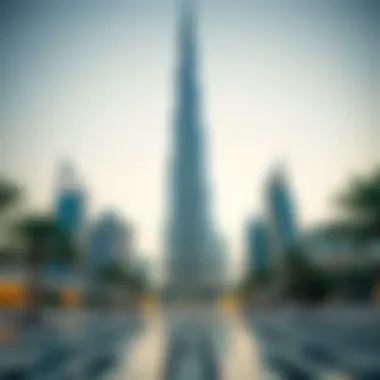

Technological Innovations
The Burj Khalifa stands as a beacon of not just architectural brilliance but also of profound technological advancements that redefined what is achievable in high-rise construction. Its design and operational features exemplify how technology can lead to efficiency, safety, and enhanced quality of life in towering structures. Here's a closer look at some of the significant technological innovations integrated into the Burj Khalifa:
Smart Building Features
The Burj Khalifa is often labeled a "smart building," a term that refers to structures equipped with advanced technology that enhances their functionality and sustainability. These smart elements are designed to optimize energy use, improve building management, and provide comfortable living and working conditions.
- Intelligent Management Systems: The building utilizes a centralized control system that monitors and manages lighting, temperature, and security across various floors. This connectivity not only streamlines operations but also helps in conserving energy, as heating and cooling can be adjusted based on occupancy and time of day.
- Sustainable Practices: The integration of energy-efficient technologies, such as high-performance glass that reduces heat gain, significantly lowers the energy consumption. The use of recycled materials in construction further emphasizes sustainable practices.
"Smart technologies in the Burj Khalifa ensure not only comfort but also a reduced environmental impact, setting a precedent for future developments."
Elevator Technology
One of the engineering feats of the Burj Khalifa is its elevator system. Occupying a central part of the building’s functionality, the elevators are equipped with cutting-edge technology that enables efficient movement across the building's 163 floors.
- High-Speed Elevators: The Burj Khalifa is home to some of the fastest elevators in the world, reaching speeds of up to 10 meters per second. With multiple elevator banks servicing different zones of the building, wait times are minimized, and accessibility is optimized.
- Double-Decker Elevators: This unique feature allows two floors to be served simultaneously, increasing efficiency even further. Passengers can have direct access to the observation deck on the 148th floor without needing to change elevators, which significantly enhances the user experience.
Safety Measures
When it comes to skyscrapers, safety is paramount. The Burj Khalifa incorporates several advanced safety features to ensure the well-being of its occupants.
- Fire Safety Systems: The building is fitted with state-of-the-art fire detection and sprinkler systems. Additionally, the use of non-combustible materials in construction plays a significant role in fire prevention.
- Emergency Evacuation Protocols: In the event of an emergency, specially designed stairwells and pressurized elevator systems allow safe evacuation while preventing smoke entry into exit routes.
- Seismic Resilience: Built to withstand high winds and seismic activities, the Burj Khalifa's structural details incorporate flexible materials and an innovative foundation that anchors the building securely to the ground.
In sum, the Burj Khalifa is not only a structural marvel but also a showcase of technological innovation, embodying standards that many future constructions will aim to meet. This building demonstrates how technology, when seamlessly integrated into design, can elevate both functionality and efficiency in modern architecture.
Urban Impact and Future Developments
The Burj Khalifa serves not just as a marvel of engineering but also as a pivotal player in shaping Dubai’s urban landscape. As the tallest structure in the world, its influence extends beyond aesthetics and draws attention to the ongoing evolution of urban development in the region. Understanding the urban impact and future developments ushered in by the Burj Khalifa reveals a broader narrative about Dubai's aspirations and its positioning on the global stage.
Urban Planning in Dubai
Urban planning in Dubai has undergone a tremendous transformation in the last few decades. With rapid modernization, the city has emerged as a global hub for business, tourism, and culture. The Burj Khalifa plays a crucial role in this metamorphosis, acting as a catalyst for growth in various ways:
- Economic Activity: Its presence has significantly boosted the commercial real estate sector. New businesses have flocked to the vicinity, encouraged by the prominence of the Burj Khalifa, creating jobs and stimulating economic growth.
- Tourism Destination: Visitors from around the globe are drawn to the tall tower, increasing foot traffic across the city, and supporting local businesses ranging from restaurants to retail shops.
- Infrastructure Development: The surrounding area has seen extensive infrastructure upgrades. Roads, public transport, and leisure spaces have improved as city planners work to accommodate the increasing volume of residents and visitors.
The Burj Khalifa is not just an isolated structure; it is the linchpin of an entire district characterized by ambitious urban planning.
Future Projects Reignited by the Burj Khalifa
The influence of the Burj Khalifa extends into future developments across Dubai. Its iconic status has inspired various projects intended to either replicate its success or complement its grandeur:
- Dubai Creek Tower: This upcoming skyscraper aims to surpass the Burj Khalifa in height and prominence, illustrating the ambition to push architectural boundaries even further.
- The Dubai Frame: Though not as lofty, this innovative structure symbolizes the merging of past, present, and future, representing a different dimension to the city’s skyline.
- Life in the Sky: Projects focusing on vertical living and urban gardens are emerging, inspired by the Burj Khalifa’s multi-purpose use.
These initiatives not only represent architectural ambition but also underscore a commitment to enhancing urban experiences for both residents and visitors.
Sustainable Urban Initiatives
As the world turns its focus towards sustainability, the Burj Khalifa is at the forefront of several sustainable urban initiatives that aim to mitigate environmental impacts:
- Energy Efficiency: The building incorporates advanced technologies that reduce energy consumption. Solar panels and efficient lighting systems showcase an initiative to harness renewable energy.
- Water Conservation: A system for recycling water used in landscaping and cooling helps in reducing the overall water footprint. It sets an example for forthcoming urban projects that prioritize conservation.
- Public Spaces: The areas surrounding the Burj Khalifa include green zones and parks that allow for leisure. This encourages residents to spend time outdoors, benefiting their well-being while promoting eco-friendliness.
In essence, sustainable urban initiatives associated with the Burj Khalifa portray a vision where architectural innovation harmonizes with ecological responsibility, paving the way for future developments in Dubai.
Epilogue
The Burj Khalifa stands as a pinnacle of achievement, heralding a new era in architectural innovation. Its towering presence is not just a testament to what can be accomplished with visionary planning but also highlights the profound impact such structures can have on their surroundings.
The Legacy of Burj Khalifa
The significance of the Burj Khalifa extends far beyond its impressive height. It serves as a beacon of progress, symbolizing Dubai's ambitious spirit and commitment to growth. This structure has transformed the skyline, and with it, the very fabric of the city.
- Cultural Icon: The Burj Khalifa is emblematic of a modern Dubai, attracting millions of tourists each year who come to witness not just its architectural beauty, but also the experiences it offers.
- Economic Catalyst: Its presence boosts local businesses and elevates property values. Nearby developments have sprung up, driven by the allure of the iconic tower, creating a ripple effect throughout the surrounding areas.
- Inspiration for Future Developments: As a landmark, it paves the way for future architectural endeavors. Architects and developers look to the Burj Khalifa for inspiration, setting a precedent in design and engineering.
Reflections on Urban Development
In discussing the Burj Khalifa, it’s crucial to consider its impact on urban development. Reflecting on how it has reshaped the city offers valuable insights:
- Revitalization of Urban Spaces: The area around Burj Khalifa has undergone significant redevelopment. Parks, shops, and entertainment districts have flourished, creating a vibrant urban environment.
- Sustainable Urban Practices: This landmark has sparked conversations around sustainability in architecture. As cities worldwide face challenges from rapid urbanization, the techniques used in the construction and maintenance of the Burj Khalifa serve as a model.
- Policy Influence: Its success encourages local governments to invest in infrastructure and urban renewal projects. The Burj Khalifa illustrates the positive influence that iconic structures can have on urban policy and planning.
The legacy of the Burj Khalifa and its influence on urban development continues to shape the dialogue around architecture, sustainability, and economic growth. As Dubai forges ahead, the lessons learned from this remarkable skyscraper will undoubtedly inform future developments, not just in the region, but across the globe.





